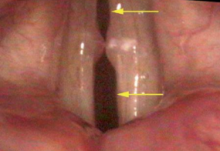Faith N. Metsan showed up at Dr. Goodew’s office saying she was hoarse. Like Faith, most of us have a general idea about hoarseness, though perhaps without really knowing what it is in any detail. A performer often knows when her voice is not working well because the change is sudden. She has thousands of hours hearing her own voice for comparison. Yet, singers and performers stake their entire careers on their voice and many have never seen nor had any concrete visual concept of what was transpiring inside their necks.
Yet even for a singer, a very slow change is not very noticeable. She would tend to gradually alter her vocal closure during the slow development of a voice problem, effectively compensating for or hiding the change. She will often attribute vocal problems to a change in technique. Quite often, someone else recognizes the hoarseness first, because it is a change from the last time he heard her sing.
Hoarseness is a common complaint at the doctor’s office. Where is the hoarseness coming from? What specifically is wrong when we are hoarse? Without a definition of hoarseness, we don’t really have an answer to any of these questions.
In a pure science mode, I could technically view hoarseness as an impairment of the signal-to-noise ratio of the human voice, yet a more descriptive definition might be more helpful in the clinic. Consequently, I think of hoarseness as an unwanted leak of air though the vocal cords or the irregular leak of air through the vocal cords. This is an often neglected, but incredibly helpful definition.
 Again, there are only two ways to be hoarse:
Again, there are only two ways to be hoarse:
1. Air is leaking when you don’t want it to leak.
2. The vocal cords are vibrating irregularly.
That is it. That is the essence and foundation of my entire book. In every patient who complains of hoarseness, we will find one of these two problems: air leak or irregular vibration or some combination of both. Fortunately, it is possible to see air leaking or vocal cords vibrating irregularly, at least with the technology available today.
For Faith though, until someone puts a mirror or a camera into her throat, the diagnosis about what is making her hoarse is probably a guess, perhaps a simple guess, a statistical guess or perhaps an educated guess. However, even without an endoscope, let’s try to improve on this guess since anyone, including you, can listen to the voice. We can hear air leak and we can hear irregular vibrations.
Faith’s story is just one of the many anecdotes found in my recent book, “Why is There a Frog in my Throat: A Guide to Hoarseness.”
